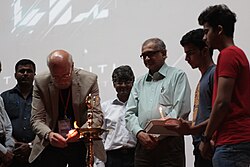Blog Credit : Trupti Thakur
Image Courtesy : Google
India’s 6g Technology Development
In a significant step towards developing Indigenous technology, the Centre for Development of Telematics (C-DOT), a premier Telecom R&D centre of the Department of Telecommunications (DoT), Government of India, signed an agreement with the Indian Institute of Technology Roorkee (IIT Roorkee) and Indian Institute of Technology, Mandi (IIT Mandi), for the development of ‘Cell-Free’ 6G Access Points. Both the IITs are collaborating to develop this technology.
The agreement is signed under the Telecom Technology Development Fund (TTDF) scheme of Department of Telecommunications, Government of India, which has been designed for providing funding support to domestic companies, Indian startups, academia and R&D institutions involved in technology design, development, commercialization of telecommunication products and solutions. This scheme aims to enable affordable broadband and mobile services, playing a significant role in bridging the digital divide across India.
Traditional mobile networks use cellular topologies in which each cell is serviced by a single base station like 4G/5G to service mobile customers. ‘Cell-Free’ Massive MIMO (multiple-input and multiple-output) eliminates the idea of cells and cell boundaries by deploying several access points (APs) across a vast region to serve many user devices at the same time. A large number of APs are dedicated to each user within their coverage area, meaning a single user may be supported by many Aps. This ensures ubiquitous connectivity to the users, eliminates dead zones, enhances signal strength, and significantly boosts data speeds, offering an exceptional user experience even in densely populated areas.
This 6G project will focus on developing APs for enabling the upcoming 6G radio access networks and also aims to contribute to the 6G standardization activity, drive commercialization, generate intellectual property rights (IPRs), and develop a skilled workforce to support the emerging 6G landscape.
The agreement was signed during a ceremony attended by CEO, C-DOT – Dr Rajkumar Upadhyay, principal investigator – Dr Abhay Kumar Sah from IIT Roorkee, co-investigator – Dr Adarsh Patel from IIT Mandi and Director C-DOT, Dr Pankaj Kumar Dalela.
At the event, Dr Sah and Dr Patel affirmed their dedication to advancing next-generation communication technologies, aligning with Bharat 6G Vision launched by Prime Minister Shri Narendra Modi. They expressed their gratitude to Department of Telecommunications (DoT) and C-DOT for the opportunity to collaborate on this research, emphasizing that it bolsters efforts to enhance cutting-edge research capabilities and infrastructure in the telecom sector.
Dr Rajkumar Upadhyay, CEO, C-DOT underscored the key role of indigenously designed & developed technologies in meeting the specific requirements of communication for our diverse country, reaffirming the commitment towards “Atmanirbhar Bharat”. He also said this will help us generating IPRs in 6G domain and emerging technologies in the area of 6G.
The C-DOT, IIT-Roorkee & IIT-Mandi representatives expressed their enthusiasm and commitment to this collaborative endeavour on developing and shaping the 6G vision of India.
India’s Department of Telecommunications (DoT) said in July 2024 that it wanted to improve 6G technology that was already in the country. The project aims to create “Cell-Free” 6G Access Points by working with IIT Roorkee and IIT Mandi. This will help shape the future of mobile communication.
Partnerships for Development
Working together with C-DOT and top Indian Institutes of Technology is very important for developing 6G technology. The main goal of this Memorandum of Understanding (MoU) is to build access points, which are necessary for setting up 6G networks.
Objectives of the 6G Project
The 6G project’s goals are to:
· Create entry points for radio access networks of the future.
· Contribute to making 6G technologies more uniform.
· Make things be sold and create intellectual property rights (IPRs).
· Prepare a skilled workforce for the changing business world.
Understanding ‘Cell-Free’ Massive MIMO
Cell-based design is how most mobile networks work. ‘Cell-Free’ Massive MIMO technology, on the other hand, uses many access points spread out in an area to work together. The following are some good things about this system: Connectivity everywhere, with fewer dead spots; stronger and more reliable signals; and much faster data speeds for users, especially in areas with lots of people. Overall, this project is a big step forward for improving India’s communications and lays the groundwork for the 6G age that is coming soon.
About 6G telecommunications
The goal for 6G connectivity, which is expected to be available around 2030, is speeds of more than 100 Gbps. Terahertz frequencies will be used, allowing for very low delay of just 1 millisecond. Holographic contact and advanced IoT networks are two important uses. 6G could use network control that is driven by AI to work better. It could be used for new things, like remote surgeries and realistic augmented reality. 6G is also expected to improve connection around the world, filling in broadband gaps in rural areas. Sustainable infrastructure that has less of an effect on the environment is the subject of research.
Blog By : Trupti Thakur

31
JulIndia’s 6g Technology Development
Jul 31, 2024Recent Blog
Quantum Gravity Gradiometer PathFinderApr 28, 2025
The TechKriti 2025Apr 26, 2025
India’s First Quantum Computing VillageApr 24, 2025
India’s Achievement In QKDApr 22, 2025
The V2G TechnologyApr 21, 2025




